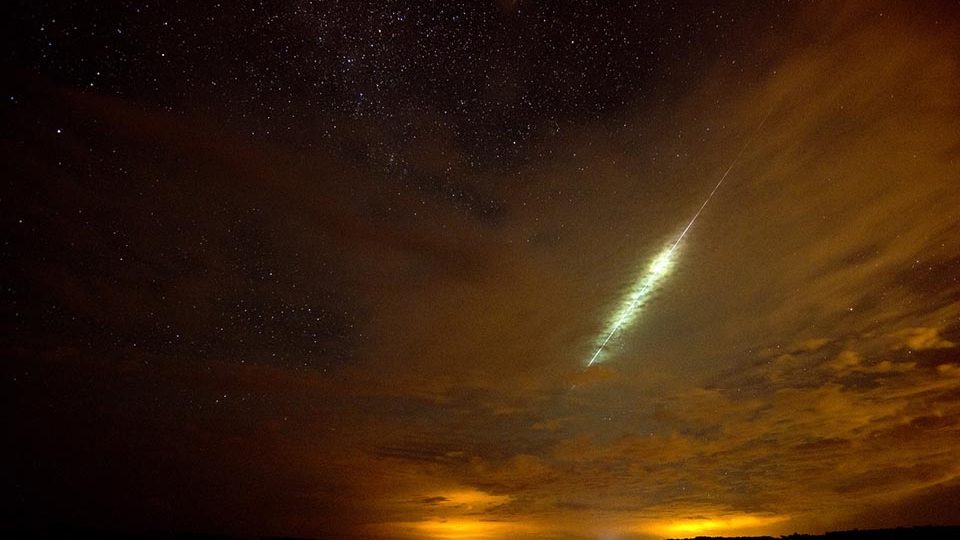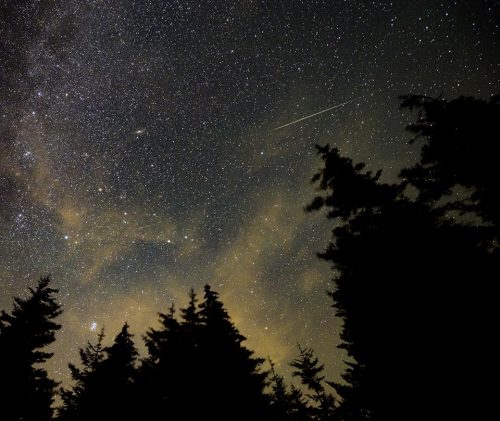Nature’s Really Big Show
Tired of noisy fireworks? Well, the heavens have a show for you—coming soon, to a dark sky near you!


The Perseid meteor shower is one of the summer’s celestial highlights. For nighttime viewing, few if any things offer the drama of this annual show. Depending on the source you consult, the showers begin on the 17th of July and end on August 24 (Royal Greenwich Museums) or they run from July 14 to September 1 (National Aeronautics and Space Administration). The beginning date is not as important as the peak, on which there is consensus—August 12 and 13.
I’ve seen it rainin’ fire in the skyTalk to God and listen to the casual replyRocky Mountain high (Colorado)Rocky Mountain high (high in Colorado)
- 109/Swift-Tuttle, Science.nasa.gov
- NASA’s – Ten Facts About Meteors, nasa.gov
- Lowell Observatory, View From Mars Hill: The Return of the Perseid Meteor Shower, by Kevin Schindler, 2021.
- Farmers’ Almanac, “August Night Sky,” www.farmersalmanac.com
- The phone apps PLANETS can give you up-to-date information on celestial happenings.
How To Enjoy the Show
According to NASA, “Approximately 30 meteor showers occur each year that are visible to observers on Earth. Some of these showers have been around longer than 100 years. The Perseid meteor shower, which occurs each year in August, was first observed about 2,000 years ago and recorded in the Chinese annals.”
The peak evenings to view the Perseid meteor shower are Monday, August 12, and Tuesday, the 13th. You will want a dark sky and a cloudless, or nearly cloudless, evening. Optimal viewing times are from midnight to 4 a.m. The moon on these two dates rises at 1 p.m. and sets by 11:30 p.m. The moon is about half full, and a new moon or set moon is important for observation of the meteors. The greatest rate of meteors will be between midnight and 3 a.m., and most will be best viewed straight overhead.
If these dates are cloudy or your schedule is problematic, you can research days on either side of these dates for cloud cover and moon rise and set times.
A dark sky for viewing is especially important north of your viewing area. Brightly lit areas drown out the night sky, so you want to avoid lighting north of you as well as close to you.
(Ed. Note: Article to right illustrates that large meteors, or “fireballs,” are occasionally spotted during daylight hours, as occurred nearby last week.)
Dark skies are getting harder and harder to find, as people don’t employ shielded lighting and folks continually add more illumination.
Along the Bayshore is a very promising location, as is Belleplain State Forest. I’d also suggest Turkey Point, Hansey Creek, or East Point. Since it is camping time they should be open.
Further preparation should include long sleeves, long pants, a towel for dew, or a blanket (if you’re lucky and it’s a cool evening), and lastly don’t forget the bug repellent.
A folding lounge chair may help to keep you from getting a stiff neck.
Optics narrow your field of view and are not recommended for the meteors but may allow you to watch a satellite or see the rings of Saturn (Mars and Jupiter appear around 2 a.m in mid-August).
Lastly, give your eyes about 30 minutes to achieve the best night vision.
Fireball Likely Caused Those Loud Booms in NJ and NYC, Experts Say
By Len Melisurgo, NJ Advance Media for NJ.com, July 17, 2024
This story is being republished under a special NJ News Commons content-sharing agreement. Link to story: nj.com/news/2024/07/fireball-likely-caused-those-loud-booms-in-nj-and-nyc-experts-say.html
Loud mysterious booms heard on the morning of July 16 by people in New Jersey and New York City were likely caused by a bright meteor that entered the Earth’s atmosphere and streaked across the sky above the Statue of Liberty and other parts of the Garden State.
That’s the word from astronomy experts and eyewitness accounts reported to the American Meteor Society.
More than 40 people from New York, New Jersey, Pennsylvania, Connecticut, Delaware, Maryland and Rhode Island reported they saw a very bright meteor, known as a fireball, streaking across the sky at about 11:17 a.m. on that day.
Some of the people who saw the fireball also heard a loud boom at the same time. Many people in towns across northern and central New Jersey reported hearing strange booms or feeling their doors and windows rattle during the same time-frame, even though they didn’t see the fireball.
Astronomy experts say small meteors can sometimes create sonic booms similar to the loud explosive sounds and rumbling generated by fighter jets as they fly overhead. And some witnesses who reported seeing the fireball said they heard what clearly sounded like a sonic boom.
Harold Kozak, a retired astronomy professor and a NASA solar system ambassador from Staten Island, said he heard a booming sound late that morning, looked outside and didn’t see any rain or thunderstorms, so he quickly realized he had heard a sonic boom.
During an interview on WOR radio in New York the following morning, Kozak said small space rocks like last week’s meteor originate far out in space, in the outer part of the solar system, and sometimes they make their way to our planet.
“These things get dislodged. They get pulled in by gravitational pull of the sun into our solar system, and every once in a while they get close enough that they can cause these sonic booms and fireballs,” Kozak said on WOR.
“Most of the time, it could be the size of a pebble,” Kozak said. “When (a meteor) the size of a pebble enter’s our Earth’s atmosphere at 30, 40, 50,000 miles per hour, the amount of friction is so intense that it lights up the sky.”
And sometimes the bright streaks of light are accompanied by a shock wave, commonly known as a sonic boom.
Amie Gallagher, director of the planetarium at Raritan Valley Community College in New Jersey, said most meteors that people on Earth see streaking across the sky are actually very tiny—about the size of a fingernail—and create a shooting star effect.
“My guess is this was much larger than your fingernail,” Gallagher said, because the meteor was described as being extremely bright and was clearly visible during daylight hours.
“People were reporting it as brighter than a full moon and as bright as the sun,” Gallagher noted.
NASA estimated the speed of last week’s fireball at about 38,000 mph and said it streaked across the sky over New York City, over the Statue of Liberty, then over eastern and north-central New Jersey. In a post on its Facebook page, NASA said this meteor was likely about a foot in diameter.
“Many folks are under the impression that NASA tracks everything in space,” the agency noted. “We do keep track of asteroids that are capable of posing a danger to us Earth dwellers, but small rocks like the one producing this fireball are only about a foot in diameter, incapable of surviving all the way to the ground. We do not (actually cannot) track things this small at significant distances from the Earth, so the only time we know about them is when they hit the atmosphere and generate a meteor or a fireball.”
“Also, NASA watches the natural stuff,” the agency added. “The Department of Defense keeps track of satellites and orbital debris.”









